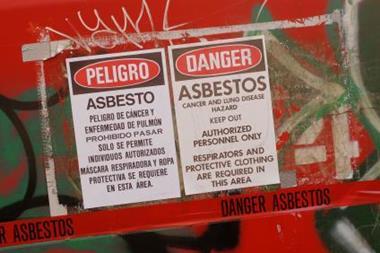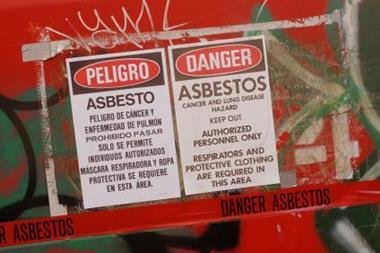What the trigger ruling will mean – and what happens next
Overview
When Mr Justice Burton announced one of the most important legal decisions for mesothelioma sufferers and the insurance industry in recent history, no shrieks or gasps were heard in the High Court.
Six test cases had been brought over whether employers’ liability insurance was triggered when an employee was first exposed to asbestos, or when the employee’s mesothelioma actually developed.
Mesothelioma is a devastating disease: most victims die within two years of diagnosis. Yet there was a seemingly blasé shuffling of papers and murmuring from the bewigged lawyers after the judgment on 21 November, which reaffirmed that insurers that had provided cover at the time someone was exposed to asbestos must pay compensation.
But the muted reaction wasn’t because the test case results didn’t matter. It was because the judgment wasn’t a full conclusion – rather, this was the end of round one. The first five rows of the courtroom were taken up with lawyers and their clients, who had already known the result for 10 days. And whatever way the verdict went, an appeal was a certainty.
Previous asbestos cases have been fought all the way to the House of Lords and this one is unlikely to be different. The asbestos “trigger litigation” has been one of the most bitterly contested battles of recent years, dividing the industry.
On average, it takes 35 to 40 years to get from asbestos exposure to a diagnosis of mesothelioma. By that time, the company the victim worked for might no longer be trading.
If that were the case, and the argument against the 21 November ruling had succeeded, the victim would not have been able to claim compensation.
Zurich had joined victims’ families and employers, as well as local authorities, in supporting the judgment. Four insurers in run-off – Builders’ Accident Insurance (BAI), Excess, Independent and Municipal Mutual – had countered the argument by calling into question the wording of employers’ liability policies.
The Bolton case and its aftermath
For decades, insurers paid asbestos claims on the basis that inhalation of the substance was the trigger. But a public liability (PL) case in Bolton in 2006 shook insurance to its core. An electrician, Gordon Green, died of mesothelioma in 1991, many years after inhaling the lethal fibres on a job for Bolton council.
The insurer on risk at the time of inhalation, Commercial Union, said its policies were worded to cover some variation of “injury sustained” or “disease contracted” during the term of employment.
In the case of mesothelioma – undreamt of when the policies were written – no injury happens until many years later. In the Bolton case, the date of injury was assumed to be 10 years before diagnosis. Commercial Union claimed the insurer on risk at that later date – Municipal Mutual – should be liable to pay compensation. The Court of Appeal agreed, opening the door for renewed scrutiny of PL policies and employers’ liability (EL) too.
A significant chunk of the EL business written in the 1960s and 1970s contains the disputed wording, variations of which are represented by the six test cases. Since the Bolton judgment, BAI had rejected 284 EL mesothelioma claims, Independent 41, Excess 151 and Municipal Mutual 169.
The task for Mr Justice Burton was to decide if the “Boltonites” were right, or if EL policies should pay out as they always had done.
Charles Gordon, a partner at DLA Piper, represented BAI and Independent, both insolvent and being run off by Pricewaterhouse Coopers. “They want clarification of the law,” he says. “Ever since the Bolton decision in 2006, there has been uncertainty as to what the trigger is for liability. My client is in the position of not knowing how they should respond to claims.”
But according to Alan Hunter, technical claims manager at Zurich: “Only a few companies take the Boltonite view – ex-companies, people with no customers.
“But we have a long-term future in this business and we take the view that someone’s got to say, ‘That’s not the right way of reading it’.”
Hunter says EL and PL cannot be treated in the same way. “PL was always written on an injury-occurring basis, but EL policies have always been written on a caused [point of exposure] basis. We didn’t think it was fair to take the decision on public liability and lift it into the EL arena. It’s totally different.”
But the real danger of a Boltonite victory was that many EL policyholders would find they were left with no insurance. Accepting that the policies on risk at the time of exposure were not liable would lead to holes in cover – where for example, the policy at the tumour date used the “caused” wording, or ruled out asbestos-related claims, as many began to do from the 1980s.
Costs and claims
The six test cases were heard over a two-month period and involved about 20 barristers instructed by 14 firms of solicitors. Legal costs were steep – Zurich for example, on the winning side, was awarded interim costs of £1m.
But the sums at stake for the opposing insurers were far greater. Calculating asbestos liabilities takes up a great deal of time and no one is sure of the eventual figures. But everyone agrees they will be a large drain on reserves.
According to the UK professional body, Actuarial Profession, about 9,000 people had died in the UK from mesothelioma by the end of 2003 and the industry had paid out £1.3bn in claims – a fraction of the eventual total.
A survey of major insurers predicted between 80,000 and 200,000 claims in the next 30 years, at a future cost of £4bn to £10bn. Deaths now top 2,000 a year, but are not expected to peak until 2011 to 2015. Health & Safety Executive (HSE) data shows there were 2,037 deaths in 2005. It expects the number of deaths to peak at about 2,450, before tailing off by the year 2040.
Actuarial Profession’s latest report, UK Asbestos Working Party Update 2008, reveals that the number of claims is now significantly above the number of mesothelioma deaths. The working party investigated factors that might have caused this, such as a rise in propensity to sue, more claims being shared between insurers and EL cover becoming compulsory in 1972.
It also considered claims being identified faster, a catch-up from claims that were on hold due to legal cases and the possibility that the HSE was under-estimating deaths.
While those factors were found to have had a small impact, the working party concluded that the main driver is the rise in the proportion of mesothelioma sufferers who are making claims. In 2004, Actuarial Profession estimated that about one third of mesothelioma sufferers were making claims. But it says this proportion has risen from 36% in 2003 to 56% in 2007.
Claims are rising, it says, because of increased publicity and because more relations of the deceased are launching retrospective cases. The internet is another factor, enabling sufferers to access specialist information and communicate with interested parties. Pre-death diagnosis has also increased.
Meanwhile, according to KPMG’s annual run-off survey of the UK non-life market, the size of liabilities for last year was £28.3bn. Much of this related to asbestos exposure.
The survey said almost one third (£9.1bn) of the liabilities in the UK non-life run-off market are held in the balance sheets of insolvent insurers. Chester Street Insurance Holdings (formerly Iron Trades) is the largest insolvency. Its UK asbestos liabilities are about £3bn – more than 10% of the total liabilities of the UK non-life run-off market at the end of 2007.
The government’s Financial Services Compensation Scheme (FSCS) offers another avenue for payouts. But if cover was triggered at the time the cancer develops and not at exposure, there would be a gap in cover if the insurer at the time of trigger had become insolvent. That’s because the FSCS only pays out when there is a valid policy.
As a result, companies or councils would have to pay compensation from their own balance sheets. With claims averaging £125,000 to £175,000, this could drive a small business to insolvency or drain funds for public services.
“Two or three of those could significantly hit the balance sheet of a small or medium-sized company,” says Mark Burton, partner at Kennedys, who co-ordinated the case for the 10 local authorities involved. “This might open up other diseases beyond mesothelioma – you could apply the same analysis to any latent disease with a period between exposure and symptoms. That would be pretty massive.”
For now, though, the danger has been averted. The judgment centred on the interpretation of the contract wording: “For the purposes of these policies, injury is sustained when it is caused and disease is contracted when it is caused …”
Mr Justice Burton said the wording was unclear but, looking at the background and the commercial purpose of EL policies, he said insurers should continue to interpret them as they had done for many years.
Get ready for round two
The Boltonites were granted leave to appeal and at least some of them plan to do so. Unsurprisingly, any challenge will focus on the judge’s interpretation of the wording.
Municipal Mutual will appeal, says its lawyer, Jon Grunewald of Watmores. “My client and I feel the judgment is flawed. The judge, having carefully analysed the meaning of wordings such as caused and sustained, and having done quite a good job, copped out.
“I know why he’s done that, to protect the ex-employees. But what we’d say is that if you want to change the meanings of words to say occurring must be caused for the purpose of the EL policy, it would be a more satisfactory solution to say ‘employee equals ex-employee’ but stick to the meaning of caused. When interpreting the words of a policy, one needs to be faithful to the literal meaning and not try to impart some other meaning.”
Charles Gordon of DLA Piper says BAI and Independent are still considering whether to appeal or not, but will reach a decision well before the 5 January deadline.
“There’s quite a significant issue there on which judges might come to different views. We’re considering the implications. It’s likely some of the insurers will appeal, so the central issue will go to the Court of Appeal whether we appeal or not.”
Whatever the court decides, the government has a history of making sure the victims of asbestos-related conditions get compensation.
Henry Bermingham, a partner at Berrymans Lace Mawer, who represented several of the councils involved on 21 November, points out that in previous cases, the government has changed the law to get the right result. In 2006, it effectively overturned the Law Lords’ ruling in Barker versus Corus, which found employers were only liable for their proportion of the victim’s risk of contracting mesothelioma. The government rewrote the Compensation Act 2006 to ensure sufferers could recover full compensation.
“The government has shown a willingness to intervene in the judicial process,” says Bermingham. “It tends to wait for it to run through to the House of Lords first, though. Whether the Conservatives will have the same interest is a different question.”
Mr Justice Burton did stress that an appeal hearing should take place as soon as possible – perhaps by Easter, so the case can go all the way to the Lords before the next general election.
The judgment may also have wider repercussions for the PL claims affected by the Bolton case.
Peter Taylor, a partner in Lovells’ insurance and reinsurance business, was struck by Mr Justice Burton’s treatment of the Bolton case – the judgment drew a clear line between PL and EL policies and refused to step over it. “He’s dodged a bullet there; it was a little bit of a shimmy from the judge. But I think he’s being a little bit optimistic.
“If I was a PL insurer or broker, I’d be concerned. Bolton was a bit of a maverick case. It’s a loose end that’s going to have to be dealt with.”
Five main types of asbestos-related disease
• Calcified pleural plaques are areas of thickening on the parietal pleura – the membrane that lines the inner chest walls and covers the diaphragm. Because they occur outside the lungs, they are harmless and usually symptomless. Pleural plaques develop 15-20 years after first exposure to asbestos, but often go undetected
• Pleural thickening is thickening of the outer lining of the lung (mesothelium). Symptoms are reduced elasticity and capacity of the lungs with varying degrees of breathlessness
• Asbestosis is diffuse, interstitial fibrosis of the lungs. This tends to develop 15-40 years after first exposure to asbestos and is usually associated with dust exposure. A disabling and progressive condition, it leads to increasing breathlessness and, in extreme cases, death through heart failure
• Asbestos-related lung cancer and mesothelioma account for most asbestos-related deaths. The former is cancer of the inner lining of the lung. It is caused by heavy asbestos dust exposure and usually develops 20 years after first exposure. Since lung cancer has other causes such as smoking, there have been relatively few asbestos-related
lung cancer claims to dates
• Mesothelioma is a tumour on the outer lining of the lung, and usually fatal within two years of diagnosis. It is generally associated with amphibole asbestos fibres and can arise from very low asbestos exposures. Onset
is typically 30 to 50 years after first exposure.
Hosted by comedian and actor Tom Allen, 34 Gold, 23 Silver and 22 Bronze awards were handed out across an amazing 34 categories recognising brilliance and innovation right across the breadth of UK general insurance.










































No comments yet